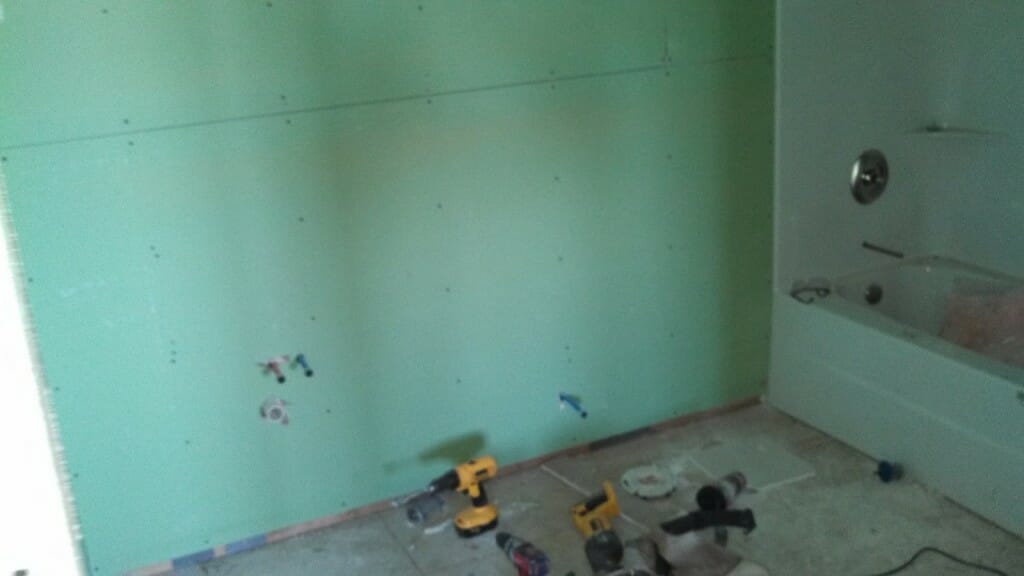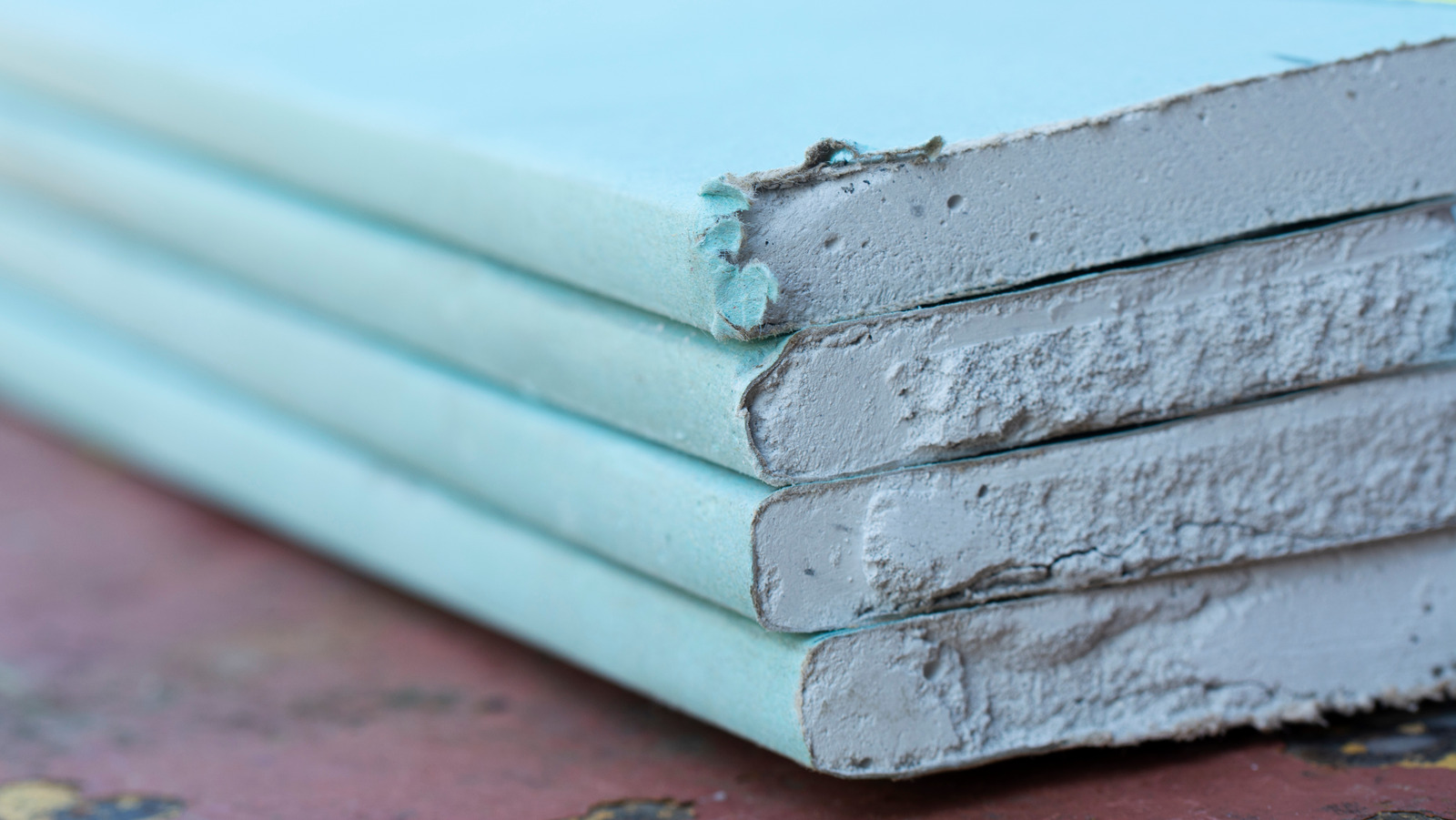What is a Green Board?: What Is Green Board For Bathroom

Green board, also known as moisture-resistant drywall or water-resistant drywall, is a type of gypsum board specifically designed for use in areas prone to moisture, such as bathrooms, kitchens, and laundry rooms. It is commonly used as a wall and ceiling covering in these areas.
Green board is made from a core of gypsum plaster sandwiched between two layers of paper, similar to standard drywall. However, the key difference lies in the paper facing. The paper facing on green board is treated with a water-resistant coating, making it more resistant to moisture damage than standard drywall. This coating helps to prevent the board from absorbing moisture, which can lead to mold growth and deterioration.
Advantages of Green Board in Bathroom Applications
Green board offers several advantages over standard drywall when used in bathroom applications:
- Moisture Resistance: The water-resistant coating on green board helps to protect the gypsum core from moisture damage, reducing the risk of mold growth and deterioration. This makes it a suitable choice for areas with high humidity levels, such as bathrooms.
- Durability: Green board is more durable than standard drywall and can withstand the rigors of bathroom use, such as splashes and spills. This makes it a more long-lasting option for bathroom applications.
- Ease of Installation: Green board is easy to install and can be cut and fastened using standard drywall tools and techniques. This makes it a convenient option for both professional and DIY projects.
Common Green Board Brands
Several reputable manufacturers produce green board, each with its unique features and specifications. Some of the most popular brands include:
- Georgia-Pacific DensArmor Plus: This green board features a moisture-resistant core and a special paper facing that is designed to resist mold growth. It also has a higher impact resistance than standard drywall.
- CertainTeed Mold Tough: This green board is formulated with a special mold-resistant additive that inhibits the growth of mold and mildew. It is also treated with a water-resistant coating for added protection.
- USG Sheetrock Brand Water-Resistant Gypsum Panel: This green board features a water-resistant core and a paper facing that is treated with a special water-repellent coating. It is also designed to resist the growth of mold and mildew.
Green Board Applications in Bathrooms

Green board, also known as moisture-resistant drywall, is a popular choice for bathroom construction due to its ability to withstand moisture and humidity. It is commonly used in various applications, including shower walls, tub surrounds, and backsplashes.
Green Board Applications in Bathrooms
Green board’s moisture-resistant properties make it suitable for various bathroom applications. Its use in shower walls, tub surrounds, and backsplashes ensures a durable and water-resistant surface.
- Shower Walls: Green board forms the base layer for shower walls, providing a solid and moisture-resistant surface for tiling or other finishes. Its moisture-resistant properties prevent water damage and mold growth, ensuring a long-lasting shower enclosure.
- Tub Surrounds: Similar to shower walls, green board is commonly used for tub surrounds. It provides a durable and water-resistant surface that can be tiled or finished with other materials, creating a visually appealing and functional tub enclosure.
- Backsplashes: Green board is also suitable for creating backsplashes in bathrooms, protecting walls from splashes and spills. Its moisture resistance prevents water damage and keeps the area clean and hygienic.
Installation Methods of Green Board
Green board installation is similar to standard drywall but requires specific considerations for bathroom environments. Its installation methods are compared to other bathroom materials, including tile and cement board.
- Green Board: Green board installation involves attaching the boards to studs or joists using screws or nails. It requires a moisture-resistant sealant around the edges and seams to prevent water penetration. The installation process is generally straightforward and can be done by DIYers with basic construction skills.
- Tile: Tile installation involves attaching tiles to a substrate, such as green board, cement board, or a concrete wall. The process requires specific tools and skills, including mixing mortar, setting tiles, and grouting. Tile installation is often best left to professionals for optimal results.
- Cement Board: Cement board is a durable and water-resistant material that is commonly used for shower walls and tub surrounds. Its installation involves attaching the board to studs or joists using screws or nails and sealing the seams with a waterproof membrane. Cement board installation is more complex than green board but offers superior moisture resistance.
Step-by-Step Guide for Installing Green Board in a Bathroom
This step-by-step guide provides a comprehensive overview of installing green board in a bathroom. It includes necessary tools, safety precautions, and detailed instructions for a successful installation.
- Gather Tools and Materials:
- Green board
- Screws or nails
- Moisture-resistant sealant
- Tape measure
- Level
- Utility knife
- Saw
- Drill
- Safety glasses
- Work gloves
- Prepare the Area:
- Clear the area of any obstructions.
- Ensure the studs or joists are properly spaced and secured.
- Clean the walls or surfaces to be covered.
- Cut and Install Green Board:
- Measure and cut the green board to fit the desired dimensions.
- Attach the green board to the studs or joists using screws or nails, ensuring they are countersunk and flush with the surface.
- Leave a gap of about 1/8 inch between each sheet of green board for expansion and contraction.
- Seal Seams and Joints:
- Apply a moisture-resistant sealant to the edges and seams of the green board, ensuring a continuous seal to prevent water penetration.
- Use a putty knife to smooth the sealant and create a clean finish.
- Finish and Protect:
- Apply a primer to the green board surface to prepare it for the final finish.
- Install tiles, paint, or other desired finishes according to manufacturer instructions.
- Ensure proper ventilation in the bathroom to prevent moisture buildup and maintain a healthy environment.
Considerations for Using Green Board in Bathrooms

Green board is a popular choice for bathroom walls and ceilings due to its moisture resistance. However, it is essential to consider the limitations and alternatives when using green board in this environment.
Moisture Resistance and Mold Prevention
Green board, also known as water-resistant drywall, is specifically designed to withstand moisture. It is treated with a water-repellent coating that helps prevent water absorption and mold growth. The coating also provides a barrier against mildew, making it suitable for humid environments.
Drawbacks of Using Green Board in Bathrooms, What is green board for bathroom
While green board is moisture-resistant, it is not waterproof. It is crucial to ensure proper ventilation and avoid prolonged exposure to standing water. Green board is not designed for direct contact with water.
Alternative Materials for Specific Bathroom Areas
For areas like shower floors and ceilings that experience direct water exposure, alternative materials are recommended.
- Shower Floors: Ceramic tile, porcelain tile, or natural stone are durable and water-resistant options for shower floors. They offer a wide range of styles and colors to match your bathroom design.
- Shower Ceilings: Acrylic or PVC panels are lightweight, waterproof, and easy to clean, making them ideal for shower ceilings. These materials are also resistant to mold and mildew, ensuring a healthy and hygienic bathroom environment.
What is green board for bathroom – Green board, also known as moisture-resistant drywall, is a staple in bathroom construction due to its ability to withstand high humidity levels. While it’s great for creating a durable and moisture-resistant surface, you’ll still need a powerful cleaning solution to keep your bathroom sparkling.
For that, you might consider using mean green bathroom cleaner , a popular choice for tackling tough bathroom grime. Once you’ve cleaned your bathroom surfaces, the green board will continue to provide a solid foundation for your bathroom’s design and functionality.
Green board, a type of drywall specifically designed for damp environments, is a common choice for bathroom walls. While it offers moisture resistance, it’s crucial to remember that even green board can be susceptible to moisture problems. If you’re dealing with persistent dampness, you might encounter green mold in your bathroom , which can be a health hazard.
Proper ventilation and prompt addressing of any leaks are essential to prevent mold growth and maintain the longevity of your green board walls.